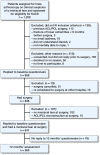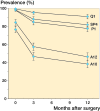Patient-reported symptoms and changes up to 1 year after meniscal surgery
- PMID: 29504818
- PMCID: PMC6055776
- DOI: 10.1080/17453674.2018.1447281
Patient-reported symptoms and changes up to 1 year after meniscal surgery
Abstract
Background and purpose - Detailed information on the symptoms and limitations that patients with meniscal tears experience is lacking. This study was undertaken to map the most prevalent self-reported symptoms and functional limitations among patients undergoing arthroscopic meniscal surgery and investigate which symptoms and limitations had improved most at 1 year after surgery. Patients and methods - Patients aged 18-76 years from the Knee Arthroscopy Cohort Southern Denmark (KACS) undergoing arthroscopic meniscal surgery were included in this analysis of individual subscale items from the Knee Injury and Osteoarthritis Outcome Score and 1 question on knee stability. Severity of each item was scored as none, mild, moderate, severe, or extreme. Improvements were evaluated using Wilcoxon's signed-rank test and effect size (ES). Results - The most common symptoms were knee grinding and clicking, knee pain in general, pain when twisting and bending the knee and climbing stairs (88-98%), while the most common functional limitations were difficulty bending to the floor, squatting, twisting, kneeling, and knee awareness (97-99%). Knee pain in general and knee awareness improved most 1 year after meniscal surgery (ES -0.47 and -0.45; p < 0.001), while knee instability and general knee difficulties improved least (ES 0.10 and -0.08; p < 0.006). Interpretation - Adults undergoing surgery for a meniscal tear commonly report clinical symptoms and functional limitations related to their daily activities. Moderate improvements were observed in some symptoms and functional limitations and small to no improvement in others at 1 year after surgery. These findings can assist the clinical discussion of symptoms, treatments, and patients' expectations.
Figures



Similar articles
-
Structural pathology is not related to patient-reported pain and function in patients undergoing meniscal surgery.Br J Sports Med. 2017 Mar;51(6):525-530. doi: 10.1136/bjsports-2016-096456. Epub 2016 Sep 16. Br J Sports Med. 2017. PMID: 27638845
-
Association of specific meniscal pathologies and other structural pathologies with self-reported mechanical symptoms: A cross-sectional study of 566 patients undergoing meniscal surgery.J Sci Med Sport. 2019 Feb;22(2):151-157. doi: 10.1016/j.jsams.2018.07.018. Epub 2018 Jul 31. J Sci Med Sport. 2019. PMID: 30100169
-
Signs of knee osteoarthritis common in 620 patients undergoing arthroscopic surgery for meniscal tear.Acta Orthop. 2017 Feb;88(1):90-95. doi: 10.1080/17453674.2016.1253329. Epub 2016 Nov 1. Acta Orthop. 2017. PMID: 27798972 Free PMC article.
-
Meniscal Root Tears Evaluation and Management.Bull Hosp Jt Dis (2013). 2018 Mar;76(1):14-21. Bull Hosp Jt Dis (2013). 2018. PMID: 29537952 Review.
-
Bucket-handle meniscal tear in a 9-year-old girl: a case report and review of the literature.J Pediatr Orthop B. 2016 Nov;25(6):570-2. doi: 10.1097/BPB.0000000000000261. J Pediatr Orthop B. 2016. PMID: 26625729 Review.
Cited by
-
Item-Specific Knee Injury and Osteoarthritis Outcome Score Characterization of Patients With Medial Meniscus Root Tear.Orthop J Sports Med. 2024 Apr 12;12(4):23259671241241094. doi: 10.1177/23259671241241094. eCollection 2024 Apr. Orthop J Sports Med. 2024. PMID: 38617884 Free PMC article.
References
-
- Bannuru R R, McAlindon T E, Sullivan M C, Wong J B, Kent D M, Schmid C H.. Effectiveness and implications of alternative placebo treatments: a systematic review and network meta-analysis of osteoarthritis trials. Ann Intern Med 2015; 163(5): 365–72. - PubMed
Publication types
MeSH terms
LinkOut - more resources
Full Text Sources
Other Literature Sources
